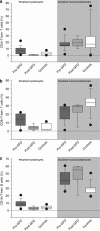Tissue-infiltrating lymphocytes analysis reveals large modifications of the duodenal "immunological niche" in coeliac disease after gluten-free diet
- PMID: 23324655
- PMCID: PMC3535075
- DOI: 10.1038/ctg.2012.22
Tissue-infiltrating lymphocytes analysis reveals large modifications of the duodenal "immunological niche" in coeliac disease after gluten-free diet
Abstract
Objectives: The role of T lymphocytes in the pathogenesis of Celiac disease (CD) is well established. However, the mechanisms of T-cell involvement remain elusive. Little is known on the distribution of T subpopulations: T-regulatory (Treg), Th17, CD103, and CD62L cells at disease onset and after gluten-free diet (GFD). We investigated the involvement of several T subpopulations in the pathogenesis of CD.
Methods: We studied T cells both in the peripheral blood (PB) and the tissue-infiltrating lymphocytes (TILs) from the mucosa of 14 CD patients at presentation and after a GFD, vs. 12 controls.
Results: Our results extend the involvement of Treg, Th1, and Th17 cells in active CD inflammation both in the PB and at the TILs. At baseline, Tregs, Th1, and Th17 cells are significantly higher in active CD patients in TILs and PB. They decreased after diet. Moreover, CD62L+ TILs were increased at diagnosis as compared with GFD patients.
Conclusions: Our data show significant modifications of the above-mentioned subpopulations both in the PB and TILs. The increase of suppressive Tregs in active CD both in the PB and TILs is intriguing. T lymphocytes are known to have a crucial role in the pathogenesis of CD. We have shown that gluten trigger results in systemic recruitment of T lymphocytes, the unbalance between pro-inflammatory and anti-inflammatory populations and the increase of CD62L+ T cells in TILs. Our results delineate a more complete picture of T-cell subsets in active vs. GFD disease. Our data of T-cell subpopulations, combined with known data on cytokine production, support the concept that duodenal micro-environment acts as an immunological niche and this recognition may have an important role in the diagnosis, prognosis and therapeutical approach of CD.
Figures



References
-
- Sollid LM, Thorsby E. HLA susceptibility genes in celiac disease: genetic mapping and role in pathogenesis. Gastroenterology. 1993;105:910–922. - PubMed
-
- Green PH, Jabri B. Coeliac disease. Lancet. 2003;362:383–391. - PubMed
-
- Giambra V, Cianci R, Lolli S, et al. Allele *1 of HS1.2 enhancer associates with selective IgA deficiency and IgM concentration. J Immunol. 2009;183:8280–8285. - PubMed
-
- Green PH, Cellier C. Celiac disease. N Engl J Med. 2007;357:1731–1743. - PubMed
-
- Ludvigsson JF, Green PH. Clinical management of coeliac disease. J Intern Med. 2011;269:560–571. - PubMed
LinkOut - more resources
Full Text Sources
Research Materials

